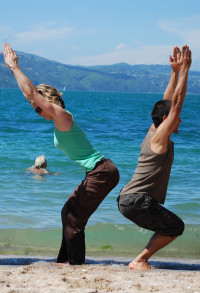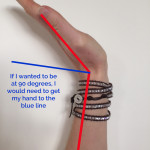 My poor ankle flexion means my knees don’t move forward at all – compared to Taisuke beside me with beautiful ankle flexion. Photo 2009
My poor ankle flexion means my knees don’t move forward at all – compared to Taisuke beside me with beautiful ankle flexion. Photo 2009by Kara-Leah Grant
This week in my Ashtanga practice I’ve been exploring and playing with two joints in particular – my ankle joints and wrist joints. Thanks to a Yin Yoga workshop, I’ve identified that I have a limited range of movement in both of these joints – less than the normal range.
The only posture that my limited ankle mobility appears to impact in the Primary Series (I’m up to Bhujapidasana (Shoulder-Pressing Pose)) is Utkatasana (Chair Pose).
Prior to the realisation about my limited range of ankle mobility due to bone compression (not tension – which can be worked on) I had been focusing on sitting deep in Utkatasana by moving my butt right back, which brought my torso down and forward. This gave me what I felt was acceptable depth in the posture. Then I focused on finding the openness to lift my torso back up to vertical.
I thought that I needed to further open my shoulders or thoracic spine to make correct alignment in Utkatasana possible, and that in time, with patience and dedication, this would happen.
However, the reality is, because my ankles lock up bone on bone and prevent my knees from sliding forward at all, my hips can’t descend without bringing my torso forward as counter-lever. Otherwise I would fall flat on my butt.
This week, I gave up sitting deep at all and instead focused on one thing only – maintaining energetic alignment of the spine in relationship to the hips and pelvis. This kept the front of my torso open and the back relaxed and strong. It meant I only bent as deep into Utkatasana as my ankles would allow me – which wasn’t much.
It was a baby Utkatasana and a tiny part of me felt like I was doing this pathetic shadow of the pose. On the outside anyway.
But on the inside, something interesting was happening.
The correct alignment and openness in my torso felt amazing. I felt heart-open and clear, like I was soaring up effortlessly into the sky. It was the feeling I have been looking for in Utkatasana for 15 years! What a delight!
Even more fascinating was that the lift, openness and soaring sensation through my torso gave me a sense of opening and release in my hips – even thought I wasn’t sinking deep into them at all. This sensation was particularly on the right side, where I’ve tended to be much tighter.
Moving into Virabhadrasana I after doing Utkatasana in this manner opened that pose up too.
Warrior I has been my nemesis for a long, long time. But in the last six months of Ashtanga practice, it’s really started to shift. I’ve learned that focusing on extending my back leg’s femur bone toward the back of my mat spontaneously releases my hips into the right position. Now, following on from the energetic openness of Utkatasana, my torso maintained the open and free feeling plus my hips felt more free too.
It was a great lesson in the value of maintaining energetic alignment in a posture and sacrificing depth.
It seems, for me in Utkatasana, that only going as deep as I could anatomically manage while maintaining clear lines of energy naturally opens the posture up from within.
In contrast, artificially going deep and then trying to manually bring myself into alignment kept me stuck for years.
The other area of limitation is my wrists. Perhaps more so than my ankles because I realised this week how often the Primary Series asks you to weight-bear on wrists that require at least 90 degrees of wrist extension.
I began to notice how I had been compensating in Chaturanga, Urdhva Mukha Savasana (Upward Dog), jump throughs, Parvsottasana and Utthita Parsvakonasana (Extended Side Angle). Plus I played in Bhujapidasana by rolling up my yoga mat and placing my palms partly on the thicker surface.
Here’s what I’ve noticed:
- I have the strength and control to work toward jump throughs, but can’t swing my torso and weight while keeping my palms flat on the ground so end up getting stuck completely.
- Whenever I do Chaturanga, my wrists are forward and my forearms on a diagonal rather than vertical.
- I can almost get into Bhujapidasana with support under my wrists, but the weight-bearing places a lot of pressure on my wrists and doesn’t feel good at all.
- If I want my palm flat on the ground in Utthita Parsvakonasana (Extended Side Angle) I have to to slide my hand forward enough so that my arm is on a diagonal which feels less stable in my shoulder joint.
- Focusing on grounding through my fingertips in postures like Urdhva Mukha Svanasana (Upward Dog) stops me from dumping into my wrist and gives me a slight space under the heel of my hand.
- I can’t bring my hands into reverse prayer behind my back in Parvsottasana – at least, not with my whole palms touching. However, if I allow my fingers to touch and create a strong connection through them, while focusing awareness on my shoulders, the posture naturally opens through the upper back and shoulders.
- The lighter I can make myself in postures – which means building more strength and deeper awareness through the pelvis and core – the more I can compensate for my limited wrist mobility.
I also learned one big lesson – there’s a fine line between being aware of one’s range of movement and using that range of movement as an excuse for not trying things, or being in certain postures.
I was wary of prefacing too much of my practice with:
‘Oh I can’t do that… it’s not possible for me.’
Instead, I focused on being curious and exploratory looking at different ways of approaching postures that embraced my limitations.
Fortunately my teacher Paul Scriven is happy to support me while I play and explore in the postures. He suggested I widen my hands slightly in Downward Dog, Chaturanga and Upward Dog, plus turn my hands slightly outward. This released pressure in my wrists, plus I noticed that it actually brought my my index finger to 12 o’clock, suggesting it might be better alignment for me anyway.
This shift in the orientation and spread of my hands helped release tension in my upper back as well.
Paul also let me explore Bhujadipadasana using knuckles to balance on rather than flat hands. It requires far more balance, and all kinds of stablisers were working hard, however it felt stronger and firmer through my shoulders and wrists. I’m still not sure if this is the way I want to approach Bhujadipasana but I appreciate having the space to explore and notice how the posture is affected by changing the hand position.
Overall, it feels like my practice is opening up in new and unexpected ways. The irony is that becoming more aware of my ‘hard’ limitations seems to be helping me soften into the places where I have far more ‘give’ available.
And that I find fascinating.
I’m no longer banging my head again brick walls. Suddenly, I can see where the doors are instead.

Leave a Reply